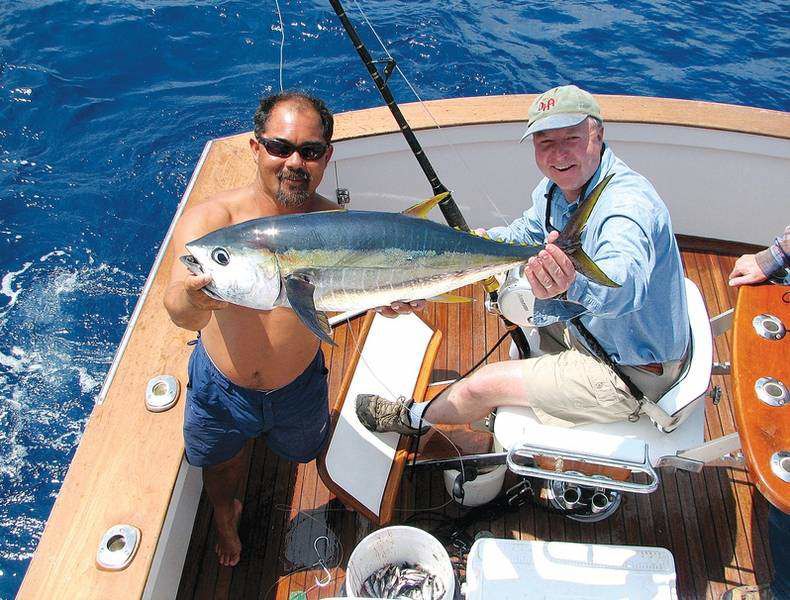Tasty tuna: 30 miles off the Kona coast
Published 5:00 am Thursday, May 3, 2007

- Dave Jarschke, right, of Bend, with Captain Kevin Nakamaru of the Northern Lights, shows off a bigeye tuna on a fishing trip in the blue water on the west side of the Big Island of Hawaii. The anglers caught over a dozen yellowfin and bigeye tuna.
Tuna seems a humble quarry when bought in two-for-a-dollar tins. Mix with mayo to make sandwiches, mix with cheese to make a casserole. Thirty miles off the Kona coast, they are a different animal.
Here, the world is blue water and sky, contained in what looks like an inverted bowl. Early in the morning, the sky is white to the east and pale blue in the west. Low clouds diffuse the sunlight and the water lifts in four-foot swells.
There’s a buoy in the deep water to provide structure in an otherwise featureless surface and the baitfish seek shelter there, attracting bigger fish.
Captain Kevin Nakamaru turns his boat, the Northern Lights, in a tight circle and throws handfuls of anchovies. In a few minutes, we see ahi. ”Little tuna,” the Captain says. ”We’ll keep this up for awhile until we bring some big ones up.”
My friend, Bitsy Kelley of Outrigger Hotels, recommended we book with Captain Kev. In his late-30s, this Hawaiian islander has a long list of credits that include three 1,000-pound-plus marlin ”granders” and a world-record thresher shark. His clients have set International Game Fishing Association world records.
On the leeward side, the waters off Kona are sheltered from the big seas and heavy trade winds by Mauna Kea and Mauna Loa. The water drops to a depth of 6,000 feet just a few miles offshore and gets deeper. It’s hard to imagine better conditions to target big blue and black marlin.
We talked about it before the trip. ”I don’t like to limit myself to one type of fishing,” Captain Kev said. ”I like to run out there and see what’s happening and then attack it.”
Today, tuna was happening.
Circling, we pulled imitation squids behind us as Kev chummed anchovies. ”There’s a big one,” Kev said. ”Now they’re coming up.”
The tuna’s back is blue-green-black to protect it from above and its belly is silver to conceal it from below. Behind the dorsal are a row of yellow-tipped fins. Built like a torpedo, the fish streaks and slashes as it feeds, its flanks flashing mylar and purple.
When the sun was behind us, the waves opened windows into the blue and we could see slashing tuna in bands of 20 to 40 fish ranging in size from five to 40 pounds. We reeled in the squids and Kev hooked a line to the 24-foot pole mounted on the top of the bridge.
He glanced at the fish finder. There was a red and yellow school of fish that was stacked 10 to 30 feet down. ”There must be 40,000 pounds of tuna in that ball,” he said.
To one rod, he tied a contraption called ”The Bird.” It’s a white winged attractor, four-feet long. To its tail is tied a buoy on a four-foot tether. Trolled behind the boat, the bird represents a toothy predator feeding on baitfish at the surface. Excited by the commotion, real toothy predators are supposed to come to the surface, where we attack them.
On the main line, spaced 10 feet apart, are four connector points where droppers, on eight-foot lines, connect with snap swivels. Yellow, orange, green and blue imitation squid were tied to the droppers.
At trolling speed, the line from the tower, connected to the fishing line, keeps the droppers above the water. When the tuna are on the surface, they can see the synchronous soaring rainbow squid. Kev jigged, controlling the tower line with his left hand, the steering wheel with his right. One moment, the squids would be three feet above the water, the next moment, they’d kiss the surface.
On the first pass, a small tuna grabbed the trailer and Kev jigged hard with the remaining baits. Wham. Another tuna grabbed a bait and Merrilee stepped into the fighting chair. The rod mounted between the fisherman’s legs and was connected by a waist belt that clipped on each side to the reel.
The biggest weighed 20 pounds; the smaller fish went back over the side. In a few minutes we had another one on. This time it was my turn to sit down, strap in, hold on and reel in a 25-pound yellowfin.
Mike Crawford caught three at once, all keepers, and our fish box began to fill, the forked tails sticking out of the ice. Dave Jarschke landed a yellowfin and a bigeye and we kept taking turns.
When the sun went down, we found our way to the Royal Jade Palace, a Chinese food restaurant in Kailua. We handed over our fillets. Twenty minutes later they brought us honey-glazed ahi, sweet and sour, black bean yellowfin and Hong Kong fried tuna.
I’ll never look at a can of tuna again without seeing the deep blue of the ocean and the way the sun plays on the purpled flanks. And I’ll remember the way tuna is supposed to taste when the fillets are fresh from the sea.






